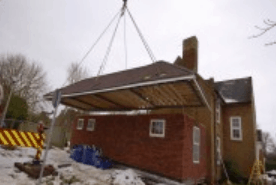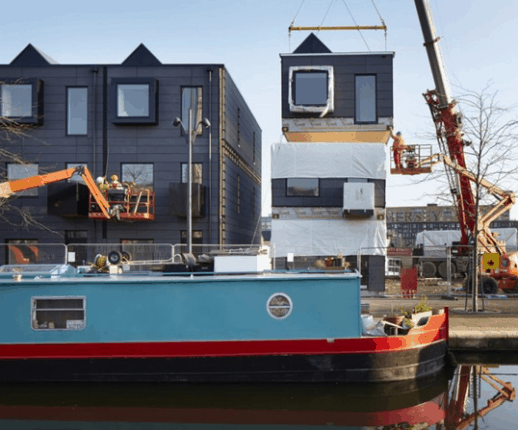
Gallions Reach in East London, UK, is home to an unused gas plant, a deteriorating shopping center and a floodplain that reaches out to the Thames River as it leaves London, an open area that gives one a slight sense of desolation, according to Inside Housing.
In the middle of the open space is a neat, modern home built offsite, a bit incongruous for the area, but a sight that could bode well for the housing industry.
Just as in the U. S. and in many countries across the globe, the lack of affordable housing is a problem here as well as elsewhere.
Housing officials estimate the need is for 250,000 to 300,000 new homes a year, while government statistics indicate the actual figure is between 140,000 and just under 200,000.
Is Off-site a Panacea?
Factory-built housing represents the possibility of precision, quick-build and a possible solution to the shortage of skilled labor, a problem that also plagues the U. S. in the site-built industry.

Noting off-site building has been around since WWI but has failed to fully catch on, there are now major players in that market that could drive the industry and help alleviate the affordable housing dilemma.
In Sweden, 80 percent of all housing has some aspect of off-site building. in Japan for residential housing, that number hovers around 50-60 percent (depending on sources). In the UK it is only five percent.
The homes at Gallions were built by llke, a partnership between developer Keepmoat and offsite provider Elliott, which has been building McDonald’s here for several decades. This represents Keepmoat’s first venture into the residential market
Currently the homes are being assembled in Elliott’s factory, where production is expected to hit 60 units this year, but talks suggest mini plants may open closer to where the homes will be sited, cutting further into development time.
Bigger Players Recently Entered the Market

As MHProNews reported here, Legal and General (L & G) opened a large factory at Leeds and is beginning to produce homes. A consortium combining Your Housing Group (YHG), renewable energy firm WeLink and the China National Building Material Company, which allegedly have large ambitions, is remaining relatively quiet about its plans.
All the builders are proposing housing totally built within the factory, including wallpaper, curtains and appliances fully installed in the homes so they will be ready to occupy within two weeks of placement on site.
Quick Turnaround
Public officials are drawn by the speed of delivery. David Lunts, executive director of housing and land at the Greater London Authority, says: “In London, we need to be building between 40,000 and 50,000 homes per year – anything we can do to encourage speed is going to be very important.”
Steve Coleman, director of development at social housing organization Lewisham Homes, says the firm will build 100 modular homes which will reduce development time by six to 12 months. “Speed means you start getting the rental income in faster, which helps with viability.”
Selling the Product
While there is disagreement about actual savings over traditional construction methods, one of the barriers is selling the public on a product that in the past has looked much like a portable cabin in some instances. The two homes at Gallions Reach appear to be made of brick.

However, in 2017, poor quality new build housing has been one of the biggest housing issues in the consumer media, as a scandal overshadowed private builder Bovis. Modern factories could potentially turn the table on poor quality. Said Lunts, “If we can start getting products built with zero or very close to zero defects that is going to do a lot to enhance the reputation of the industry.”
Mortgages may be a Sticking Point
Lenders know traditional building but have not always been comfortable with offsite. However, a new organization called Buildoffsite has created a consortium of lenders to assure the industry that the products are mortgageable in perpetuity.
Sarah Daly, director of strategic sustainability at consultancy Sustainable Homes, says, “Within five years or less, modular will be completely normalised, with most of the major house builders either owning their own factory or procuring from the existing supply chain.”
Those two houses on a deserted gas works in east London are among the first fruits of this work, but they will not be the last. ##
(Image credits are as shown, and when provided by third parties, are shared under fair use guidelines.)

